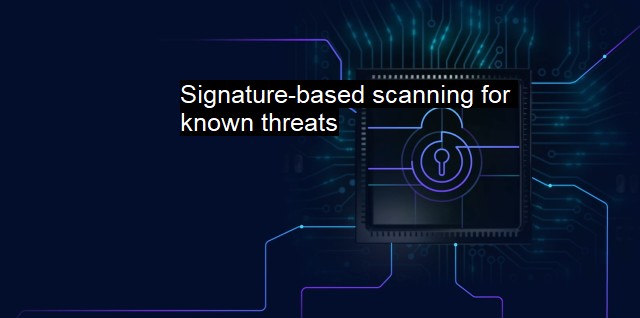What are Signature-based scanning for known threats?
The Role of Signature-Based Scanning in Cybersecurity and Antivirus Protection - A Comprehensive Overview of Malware Detection Techniques
Signature-based scanning for known threats is a pivotal technique in the realm of cybersecurity and antivirus program development. As the incidences of cyber threats continue to escalate dramatically in the digital world, the need for robust and powerful antivirus solutions has never been greater. One particularly effective method in combatting these digital threats is the use of signature-based scanning.Signature-based scanning is a method of detecting viruses, malware, and other cybersecurity threats based on their known behaviors or other defining characteristics. 'Signatures' are specific, unique sets of code or patterns that are characteristic to a particular virus or malware. These digital signatures define patterns that identify characteristics or behaviors of known threats. The types of threats detected by signature-based scanning primarily include various categories of malware including viruses, worms, and trojans among others.
In signature-based scanning, an antivirus program searches for these known signatures within the files of a system. This method relies heavily on a database of known threat signatures - an expansive, updated library of unique identifiers capable of defining each type of threat. This database contains information about all previously encountered and categorized threats, making it an invaluable ally in the defense against digital threats.
When a file is scanned, the antivirus software searches each line of code for these known signatures. If a set pattern matching a signature from the database is found, the software triggers an alert, identifies the threat, and proceeds to either quarantine or eliminate it. Due to its reliance on known patterns, signature-based scanning is particularly effective at repelling known threats.
There is a limit to its effectiveness. One of the major contrasts lies in its capability to detect and deal with unknown or emerging threats. Unlike heuristic or behavior-based analysis methods, which are designed to identify and flag potential threats based on suspicious behaviors or deviations from the norm, signature-based scanning can only identify threats that have already been defined and categorized.
Despite this limitation, signature-based scanning remains an integral part of a well-rounded cybersecurity approach. It acts as the first layer of defence against proliferating known threats. By accurately identifying and neutralizing them, it greatly reduces the likelihood of a system falling prey to these recurring threats.
Its inherent limitation of being ineffective against unknown threats reinforces the need for a layered, comprehensive approach to cybersecurity. Advanced Threat Protection (ATP) solutions commonly incorporate signature-based scanning alongside behavior-based methods to provide full-spectrum protection. This multi-layered approach ensures that both known and emerging threats are effectively dealt with, thus offering robust, all-round security to the digital environment.
Used in conjunction with other mechanisms, signature-based scanning is invaluable in creating a safe digital ecosystem. It offers the necessary understanding of known threats, helps in the categorization and labeling of such threats, thereby greatly contributing to the continued evolution of cybersecurity strategies. It allows IT security experts to devise strong defenses against known threats while also focusing their resources on developing more complex strategies to combat emerging threats.
Signature-based scanning for known threats serves as a key tool in the arsenal against cybersecurity threats. It is an effective method of identifying and mitigating the risks positioned by known threats while also serving as a springboard for the development of other defense mechanisms. Despite its limitations, when combined with a holistic cybersecurity strategy, its value is undeniable making it an indispensable component of any comprehensive security plan.

Signature-based scanning for known threats FAQs
What is signature-based scanning for known threats?
Signature-based scanning for known threats is a type of antivirus detection method that involves comparing the signature or unique characteristics of a file or code against a database of known malware signatures. This method helps to identify and block known threats that have previously been identified and added to the database.How does signature-based scanning work?
Signature-based scanning works by analyzing the code and identifying the unique characteristics or signatures of the file. This signature is then compared to a database of known malware signatures. If a match is found, the file is identified as malware and is either quarantined or deleted.What are the advantages of signature-based scanning?
Signature-based scanning is fast, efficient, and effective in identifying known threats. It is also easy to implement and can be used in conjunction with other antivirus detection methods to provide comprehensive protection against malware.What are the limitations of signature-based scanning?
The main limitation of signature-based scanning is that it can only detect known threats that have already been identified and included in the signature database. New and unknown threats that have not yet been identified and added to the database can still penetrate the system undetected, making it important to use other detection methods as well. Additionally, signature-based scanning can also result in false positives, which can cause legitimate files to be blocked or deleted.| | A | | | B | | | C | | | D | | | E | | | F | | | G | | | H | | | I | | | J | | | K | | | L | | | M | |
| | N | | | O | | | P | | | Q | | | R | | | S | | | T | | | U | | | V | | | W | | | X | | | Y | | | Z | |
| | 1 | | | 2 | | | 3 | | | 4 | | | 7 | | | 8 | | |||||||